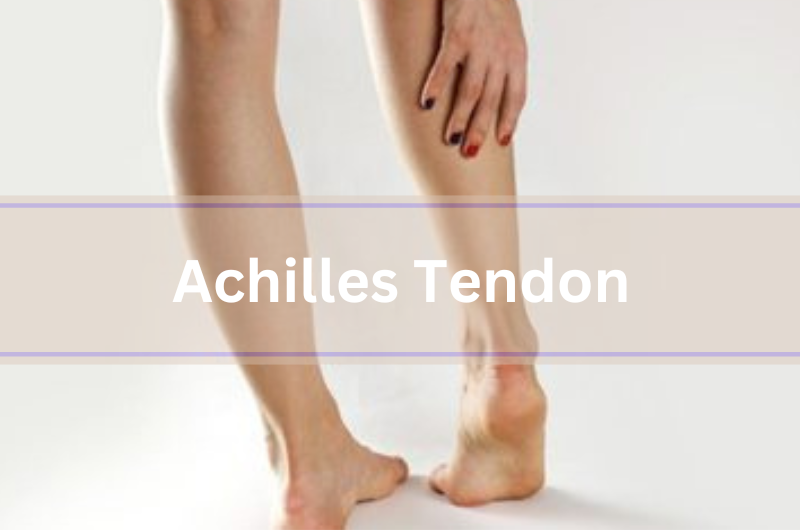Many people suffer with tight Achilles tendons, possibly limiting their comfort and ability to walk easily and usually also involved in plantar fasciitis. It is possible to tear this tendon or completely rupture it, to cause inflammation (itis) or inflame the bursa (bursitis), particularly with low rubbing shoes.
Anatomy: The achilles tendon is a tough band of fibrous tissue connecting the calf muscles (gastrocnemius and soleus) to the heel (calcaneus). These large calf muscles unite into one band of tissue forming the achilles tendon. There are small sacs of fluid (bursae) that cushion the tendon at the heel. The achilles is the largest and strongest tendon in the body; tendons attach muscle to bone. When the calf muscles work, the achilles tendon pulls on the heel, allowing us to stand on our toes as in walking, jumping and running. This strong tendon is susceptible to injury, due to the high tensions placed on it, particular during certain sports and due to its limited blood supply.
Achilles Injuries:
Tear: there can be micro tears or large tears that cause pain, swelling and limited movement. These can occur gradually over time, or suddenly in response to an impact.
Rupture: a complete rupture of the tendon, usually makes a popping sound as it happens, accompanied by pain and swelling in the calf. This is a serious injury requiring surgery and long-term immobilisation and rehabilitation. It is worth paying attention to early tensions in the hope to avoid this extreme injury.
Tendonitis: an inflammation of the tendon can occur from over activity, usually walking or running and can cause stiffness and pain in the tendon. Tendons usually get irritated in response to the tension of tight muscles pulling on them, causing inflammation where the tendon inserts into the bone. It is essential to pay attention to the muscles too.
Peritendonitis: an inflammation of the tissue surrounding the tendon, above the heel.
Tendinosis: thickening of the tendon without inflammation, usually from overuse or aging. This weakens the tendon leaving it prone to injury or rupture.
Bursitis: irritation of the fluid filled sac that cushions the achilles, causing pain at the back of the heel.
Symptoms: Pain and stiffness behind the ankle along the tendon, especially first thing in the morning. The symptoms usually come on gradually and occur while walking or running, especially on stairs or uphill; in the early stages this eases with rest. As with all inflammation, is may feel hot and swollen; it may feel tender to touch and in the longer term it may feel lumpy as scar tissues develops. A sudden total rupture in response to impact will be extremely painful and leave you unable to raise onto your toes or walk.
Causes: Basically, anything that places added strain on the tendon can cause symptoms. Common causes are misalignment and poor foot/ankle biomechanics, tight or weak calf muscles and poor or incorrect conditioning, overuse such as repetitive strain, repetitive uphill running or other stress that you are not properly conditioned and warmed up for. Also, incorrect footwear that places strain on the tendon by rubbing of positioning.
Diagnosis: Please see your doctor or physical therapist if you have an ongoing or serious issue with your achilles.
Self Help: If you have symptoms then rest from whatever is causing them, e.g. running or walking. Wear shoes with a small heal to take the pressure off the tendon, a heel lift may help and be sure your shoes do not rub or press on the painful area. Ice applied for 10-15 minutes can help to reduce the inflammation; use a bag of peas wrapped in a towel or a good spray from your pharmacy. Stretching the achilles and calves appropriately, without force and within your limits is beneficial, if not essential to good movement. I advise doing this before getting up in the morning or getting out of a chair as well as several times a day. Please watch my video on achilles stretches. There is something for everyone, with exercises standing, sitting and laying down and options for all levels of flexibility. Please only do what feels good and stay within your limits; remember that the key to stretching is listening to your body, backing off when you feel tension, approaching the tension gently and using the breathe to encourage the body to let go and release tension; stay in your comfort zone https://www.youtube.com/watch?v=wnFEbIrb0lE&t=7s
Treatment: Imaging may be required or even surgery, where there is rupture.
Osteopathic/Manual Management: Determine the cause with detailed case history and examination. Adjusting ankle and foot bones, where appropriate, soft tissue and myofascial techniques, stretching, dry needling, possibly taping, home rehabilitation exercises; attention to postural habits and ergonomics as well as advice on sports usage. Check spinal segments with nerve roots that affect the lower limb.
We are happy to advise you on your health matters.
Lin Bridgeford DO KFRP MICAK MICRA FSCCO MSc
Registered Osteopath & Kinesiologist & Senior Yoga Teacher
Master Hypnosis and NLP Practitioner
Aether Bios Clinic
Saltdean
01273 309557 07710 227038
www.osteo-info.co.uk YouTube search Aether Bios OR Lin Bridgeford Instagram linbridgeford
https://linbridgeford.wordpress.com contains all my articles as blogs
Many people suffer with tight Achilles tendons, possibly limiting their comfort and ability to walk easily and usually also involved in plantar fasciitis. It is possible to tear this tendon or completely rupture it, to cause inflammation (itis) or inflame the bursa (bursitis), particularly with low rubbing shoes.
Anatomy: The achilles tendon is a tough band of fibrous tissue connecting the calf muscles (gastrocnemius and soleus) to the heel (calcaneus). These large calf muscles unite into one band of tissue forming the achilles tendon. There are small sacs of fluid (bursae) that cushion the tendon at the heel. The achilles is the largest and strongest tendon in the body; tendons attach muscle to bone. When the calf muscles work, the achilles tendon pulls on the heel, allowing us to stand on our toes as in walking, jumping and running. This strong tendon is susceptible to injury, due to the high tensions placed on it, particular during certain sports and due to its limited blood supply.
Achilles Injuries:
Tear: there can be micro tears or large tears that cause pain, swelling and limited movement. These can occur gradually over time, or suddenly in response to an impact.
Rupture: a complete rupture of the tendon, usually makes a popping sound as it happens, accompanied by pain and swelling in the calf. This is a serious injury requiring surgery and long-term immobilisation and rehabilitation. It is worth paying attention to early tensions in the hope to avoid this extreme injury.
Tendonitis: an inflammation of the tendon can occur from over activity, usually walking or running and can cause stiffness and pain in the tendon. Tendons usually get irritated in response to the tension of tight muscles pulling on them, causing inflammation where the tendon inserts into the bone. It is essential to pay attention to the muscles too.
Peritendonitis: an inflammation of the tissue surrounding the tendon, above the heel.
Tendinosis: thickening of the tendon without inflammation, usually from overuse or aging. This weakens the tendon leaving it prone to injury or rupture.
Bursitis: irritation of the fluid filled sac that cushions the achilles, causing pain at the back of the heel.
Symptoms: Pain and stiffness behind the ankle along the tendon, especially first thing in the morning. The symptoms usually come on gradually and occur while walking or running, especially on stairs or uphill; in the early stages this eases with rest. As with all inflammation, is may feel hot and swollen; it may feel tender to touch and in the longer term it may feel lumpy as scar tissues develops. A sudden total rupture in response to impact will be extremely painful and leave you unable to raise onto your toes or walk.
Causes: Basically, anything that places added strain on the tendon can cause symptoms. Common causes are misalignment and poor foot/ankle biomechanics, tight or weak calf muscles and poor or incorrect conditioning, overuse such as repetitive strain, repetitive uphill running or other stress that you are not properly conditioned and warmed up for. Also, incorrect footwear that places strain on the tendon by rubbing of positioning.
Diagnosis: Please see your doctor or physical therapist if you have an ongoing or serious issue with your achilles.
Self Help: If you have symptoms then rest from whatever is causing them, e.g. running or walking. Wear shoes with a small heal to take the pressure off the tendon, a heel lift may help and be sure your shoes do not rub or press on the painful area. Ice applied for 10-15 minutes can help to reduce the inflammation; use a bag of peas wrapped in a towel or a good spray from your pharmacy. Stretching the achilles and calves appropriately, without force and within your limits is beneficial, if not essential to good movement. I advise doing this before getting up in the morning or getting out of a chair as well as several times a day. Please watch my video on achilles stretches. There is something for everyone, with exercises standing, sitting and laying down and options for all levels of flexibility. Please only do what feels good and stay within your limits; remember that the key to stretching is listening to your body, backing off when you feel tension, approaching the tension gently and using the breathe to encourage the body to let go and release tension; stay in your comfort zone https://www.youtube.com/watch?v=wnFEbIrb0lE&t=7s
Treatment: Imaging may be required or even surgery, where there is rupture.
Osteopathic/Manual Management: Determine the cause with detailed case history and examination. Adjusting ankle and foot bones, where appropriate, soft tissue and myofascial techniques, stretching, dry needling, possibly taping, home rehabilitation exercises; attention to postural habits and ergonomics as well as advice on sports usage. Check spinal segments with nerve roots that affect the lower limb.
We are happy to advise you on your health matters.
Lin Bridgeford DO KFRP MICAK MICRA FSCCO MSc
Registered Osteopath & Kinesiologist & Senior Yoga Teacher
Master Hypnosis and NLP Practitioner
Aether Bios Clinic
Saltdean
01273 309557 07710 227038
www.osteo-info.co.uk YouTube search Aether Bios OR Lin Bridgeford Instagram linbridgeford
https://linbridgeford.wordpress.com contains all my articles as blogs

